US-Iran crisis: Baghdad Green Zone rockets reported after Trump claims Tehran is ‘standing down’
Rockets have been fired into Baghdad’s ‘Green Zone’ – home to Australia’s embassy and those of other western nations – after US President Donald Trump said Iran “appears to be standing down”.
World
Don't miss out on the headlines from World. Followed categories will be added to My News.
- Ukraine plane crashes in Iran hours after missile strikes
- Jailed Aussie facing ‘another kind of hell’ in Iran
Rockets have been fired into Baghdad’s “Green Zone” – home to Australia’s embassy and those of other western nations.
The attack came after US President Donald Trump claimed Iran has backed off after five days of building tension between the two counties.
CNN quoted an Iraqi military source as saying two Katyusha rockets (developed in the former Soviet Union) fell inside the Green Zone but there were no casualties. Other sources said there were three rockets.
There is no evidence that the rockets were launched by Iran.
AFP correspondents in Baghdad heard two loud blasts just before 12am local time (8am AEDT), followed by the wailing security sirens of the high-security enclave where foreign embassies, including the US mission, are based.
Prime Minister Scott Morrison told reporters this afternoon that troops would remain in Iraq.
“We remain committed to carrying on this important work,” Mr Morrison said, adding that the situation had stabilised overnight.
“That means we are in a position to continue to undertake the mission that we have set for ourselves in the Middle East and we remain committed to that, as do our other partners,” he said.
Australia has several hundred troops deployed to Iraq along with a team of diplomatic staff.
The Green Zone attack came a day after Iran launched a series of missiles at the al-Assad Erbil bases in Iraq.
“Iran appears to be standing down, which is a good thing for all parties concerned and a very good thing for the world,” Mr Trump said in Washington DC shortly before midday local time (4am AEDT).
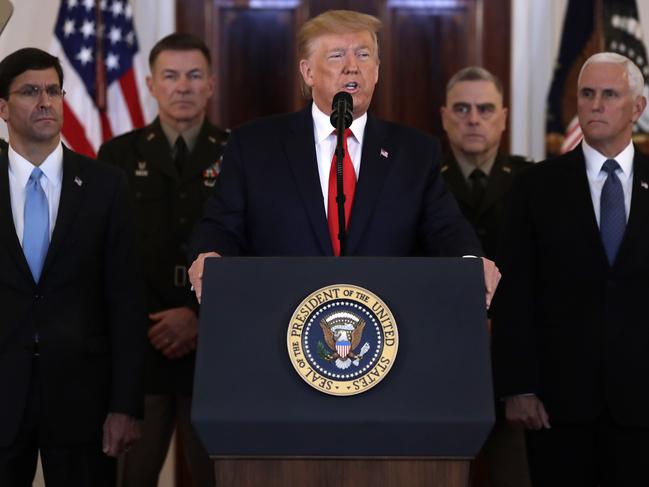
Mr Trump said he would not retaliate militarily after Iran’s missile strike on two bases in Iraq housing US and allied forces, which he said caused “minimal damage”.
Surrounded by his national defence team, including Vice President Mike Pence, Defence Secretary Mark Esper and Secretary of State Mike Pompeo, the president also announced new sanctions against the regime that would be in place until Tehran “changes its behaviour”.
“As long as I am president of the United States, Iran will never be able to have a nuclear weapon,” he said at the White House.”


“Iran is the leading sponsor of terrorism and their pursuit of nuclear weapons threatens the civilised world.”
“I am pleased to inform you the American people should be extremely grateful and happy no Americans were harmed in last night’s attack by the Iranian regime,” Mr Trump said.
“We suffered no casualties, all of our soldiers are safe and only minimal damage was sustained at our military bases.”
Iran’s revenge strike followed days of mass mourning that saw about 40 Iranians killed in a stampede before the funeral of Major General Qassem Soleimani, who was ordered killed by Mr Trump last Friday.
HOW SOLEIMANI DIED
The rocket attack on a convoy carrying Soleimani and a senior Iraq militia leader led to the deployment of 3500 additional US troops to the region and roiled financial markets.
In Washington, Mr Trump called on the United Kingdom, Germany, France, Russia and China to withdraw from the remnants of the nuclear deal.
“We must all work together to making a deal with Iran that makes the world a safer and more peaceful place.”
Mr Trump said Soleimani, the head of Iran’s Revolutionary Guard, was “the world’s top terrorist”.
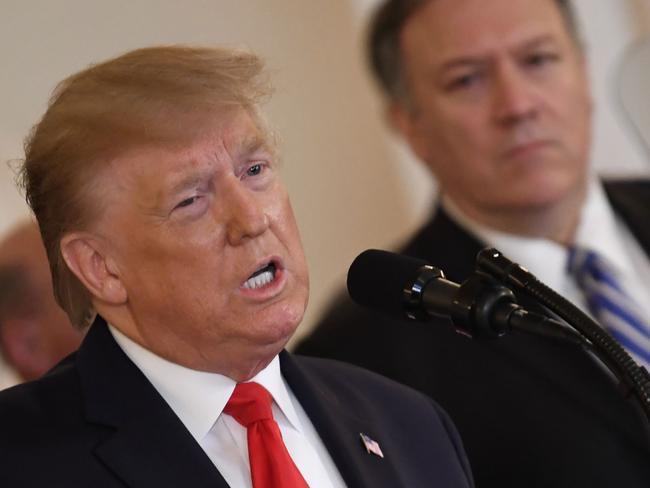
“As the head of the Quds Force, Soleimani was personally responsible for some of the absolute worst atrocities,” he said.
This included establishing Hezbollah and other terrorist armies and the spread of roadside bombs in Iraq.
“Soleimani’s hands were drenched in both American and Iranian blood,” he said.
“He should have been terminated long ago.”

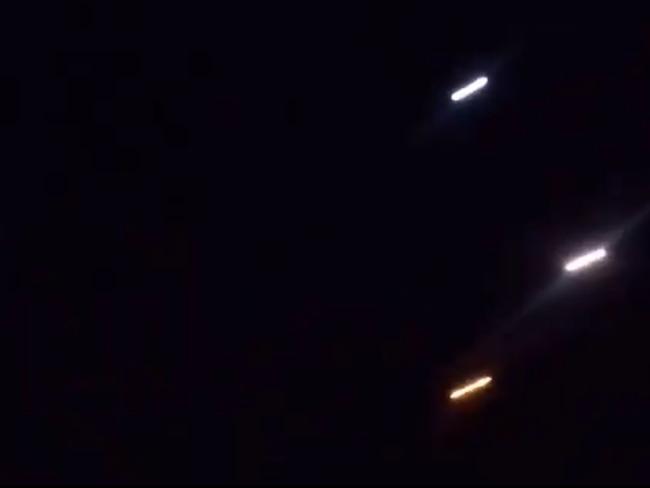
.

Supreme Leader Ayatollah Ali Khamenei made clear that Iran’s ballistic missile strikes were in revenge for the US killing of Soleimani.
“Last night they received a slap,” Khamenei said in a speech after the missile strikes. “These military actions are not sufficient (for revenge). What is important is that the corrupt presence of America in this region comes to an end.”
Early reports indicated none of the 300 Australian troops in Iraq or any Americans were hurt in the strikes, leading to speculation Iran had launched the attacks as a messaging measure.
Despite assertions of no casualties, Iran’s state news agency reported 80 soldiers were killed and 200 wounded.
There were reports of Iraqi injuries.
Iran’s Foreign Minister Mohammad Javad Zarif indicated the Iraq attacks, which were significant because they were fired from Iranian territory rather than through the proxy militias with which Tehran usually targets the US, were “proportionate measures” that would stand as the regime’s retaliation.
“We do not seek escalation or war, but will defend ourselves against any aggression,” Mr Zarif said.
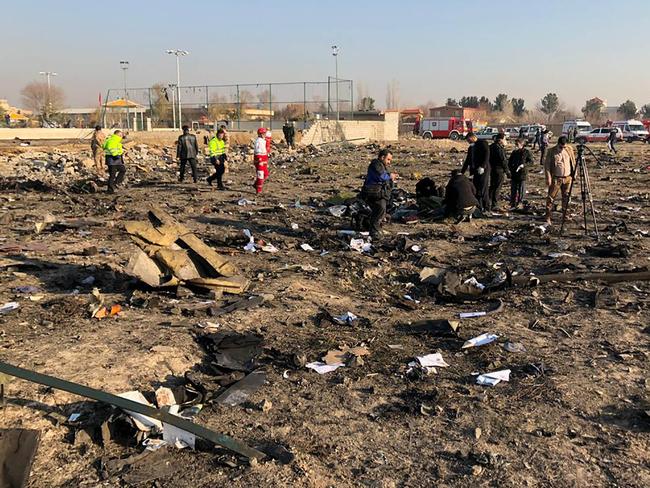
Three hours after the strikes, a Ukrainian International Airlines plane crashed at Imam Khomeini Airport near Tehran, killing 176 people on board.
The 737-800 was headed to the Ukrainian capital Kiev when it took off at 6.12am local time (1.12pm AEDT).
Preliminary reports suggested the plane experienced technical difficulties and the incident was not related to the rocket attacks.
Iraq’s parliament also voted to boot out US troops after their 17 years on the ground there, and a draft letter incorrectly sent to its government from America’s military leadership in the region saying Washington was withdrawing its presence created broad confusion about the future of the allied presence.
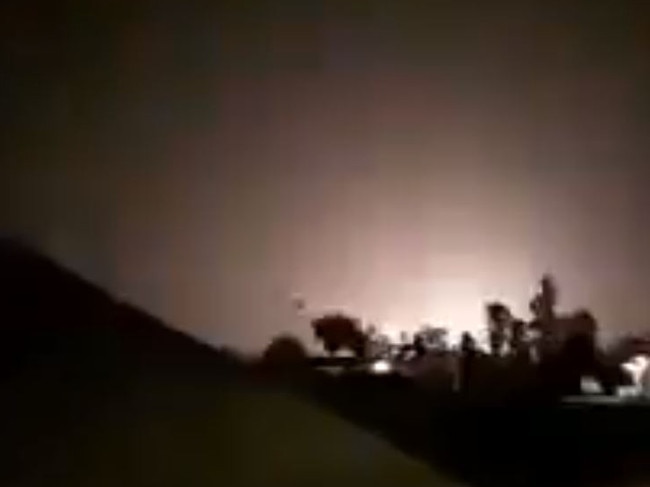
The Pentagon described the letter as a mistake and Mr Trump is pressuring Iraq to reconsider the expulsion under threat of sanctions.
The rocket strike that killed Soleimani outside Baghdad airport also placed significant domestic pressure on Iranian and US leadership, with Mr Trump accused of trying to use the conflict to distract attention from his looming impeachment trial and Tehran seeking to placate a population hungry for revenge.
The conflict presents one of the biggest foreign policy tests for Mr Trump, who campaigned and has led on a platform of ending US involvement in “endless wars” in the Middle East.
While Mr Trump limited his reaction to a single tweet, one of his closest allies took to cable TV to indicate the president was willing to step back from the threatening posture he has struck in recent days.
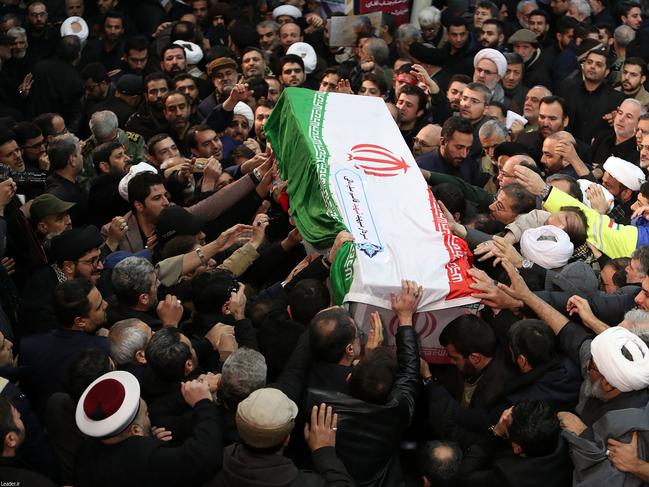
“He feels he’s got a strong hand,” Senator Lindsay Graham said on Fox News after speaking with Mr Trump.
“He doesn’t seek escalation. He is not going to tolerate provocation. He’s going to be thinking tonight along the lines to restore deterrence and how to change their behaviour.”
Allied troops including Australians were housed in the targeted bases, Erbil in northern Iraq and Al-Assad base in western Iraq, which was first used by American forces after the 2003 invasion of Iraq that removed dictator Saddam Hussein.
American troops have more recently been stationed there in the fight against Islamic State in Iraq and neighbouring Syria.
MORE NEWS
Harry, Meghan ‘considering Canada move’
‘Child’ found dead in plane landing gear
‘Unbelievable’: Ellen launches fundraiser
About 10 missiles with a 300km range hit the al-Assad base, while one struck the Erbil base, 40km from Baghdad, according to a defence official who said a further four missiles failed.
In contrast, Iraq’s military released a statement saying 22 missiles were fired, including five targeting Erbil and 17 directed at Al Assad, two of which failed.
There were also unconfirmed reports Iran warned the US shortly before the strike, giving troops time to take shelter.
Soleimani was a US-designated terrorist but also a revered figure in Iran, where for decades he headed the shadowy Quds Force, Tehran’s security operation likened to a cross between the CIA and Special Forces.
Mr Trump has repeatedly defended taking him out, saying he was responsible for the deaths of hundreds of US soldiers in Iraq and thousands of people across the Middle East.
His death came after days of tension in Baghdad including attacks on the US Embassy in Baghdad which the Pentagon said Soleimani had orchestrated.
- With AAP
Originally published as US-Iran crisis: Baghdad Green Zone rockets reported after Trump claims Tehran is ‘standing down’
